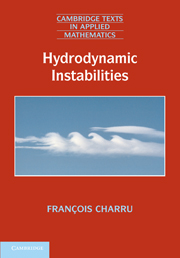Refine search
Actions for selected content:
5487 results in Thermal-fluids engineering
Appendix A3 - Tabulations of Resistance Design Data
-
- Book:
- Ship Resistance and Propulsion
- Published online:
- 07 September 2011, pp 487-521
-
- Chapter
- Export citation
4 - Static Aeroelasticity
-
- Book:
- Introduction to Structural Dynamics and Aeroelasticity
- Published online:
- 05 June 2012
- Print publication:
- 22 August 2011, pp 127-174
-
- Chapter
- Export citation
Figures
-
- Book:
- Introduction to Structural Dynamics and Aeroelasticity
- Published online:
- 05 June 2012
- Print publication:
- 22 August 2011, pp xi-xvi
-
- Chapter
- Export citation
References
-
- Book:
- Introduction to Structural Dynamics and Aeroelasticity
- Published online:
- 05 June 2012
- Print publication:
- 22 August 2011, pp 241-242
-
- Chapter
- Export citation
Tables
-
- Book:
- Introduction to Structural Dynamics and Aeroelasticity
- Published online:
- 05 June 2012
- Print publication:
- 22 August 2011, pp xvii-xviii
-
- Chapter
- Export citation
1 - Introduction
-
- Book:
- Introduction to Structural Dynamics and Aeroelasticity
- Published online:
- 05 June 2012
- Print publication:
- 22 August 2011, pp 1-5
-
- Chapter
- Export citation
3 - Structural Dynamics
-
- Book:
- Introduction to Structural Dynamics and Aeroelasticity
- Published online:
- 05 June 2012
- Print publication:
- 22 August 2011, pp 30-126
-
- Chapter
- Export citation
Foreword
-
-
- Book:
- Introduction to Structural Dynamics and Aeroelasticity
- Published online:
- 05 June 2012
- Print publication:
- 22 August 2011, pp xix-xxii
-
- Chapter
- Export citation
Index
-
- Book:
- Introduction to Structural Dynamics and Aeroelasticity
- Published online:
- 05 June 2012
- Print publication:
- 22 August 2011, pp 243-247
-
- Chapter
- Export citation
INTRODUCTION TO STRUCTURAL DYNAMICS AND AEROELASTICITY, SECOND EDITION
-
- Book:
- Introduction to Structural Dynamics and Aeroelasticity
- Published online:
- 05 June 2012
- Print publication:
- 22 August 2011, pp xxiii-xxiv
-
- Chapter
- Export citation
2 - Mechanics Fundamentals
-
- Book:
- Introduction to Structural Dynamics and Aeroelasticity
- Published online:
- 05 June 2012
- Print publication:
- 22 August 2011, pp 6-29
-
- Chapter
- Export citation
Appendix A - Lagrange's Equations
-
- Book:
- Introduction to Structural Dynamics and Aeroelasticity
- Published online:
- 05 June 2012
- Print publication:
- 22 August 2011, pp 231-240
-
- Chapter
- Export citation
Frontmatter
-
- Book:
- Introduction to Structural Dynamics and Aeroelasticity
- Published online:
- 05 June 2012
- Print publication:
- 22 August 2011, pp i-vi
-
- Chapter
- Export citation
5 - Aeroelastic Flutter
-
- Book:
- Introduction to Structural Dynamics and Aeroelasticity
- Published online:
- 05 June 2012
- Print publication:
- 22 August 2011, pp 175-230
-
- Chapter
- Export citation
Contents
-
- Book:
- Introduction to Structural Dynamics and Aeroelasticity
- Published online:
- 05 June 2012
- Print publication:
- 22 August 2011, pp vii-x
-
- Chapter
- Export citation

Hydrodynamic Instabilities
-
- Published online:
- 05 August 2011
- Print publication:
- 30 June 2011
Preface
-
- Book:
- Essentials of Heat Transfer
- Published online:
- 05 June 2012
- Print publication:
- 01 August 2011, pp xvii-xx
-
- Chapter
- Export citation
Frontmatter
-
- Book:
- Essentials of Heat Transfer
- Published online:
- 05 June 2012
- Print publication:
- 01 August 2011, pp i-vi
-
- Chapter
- Export citation
Nomenclature
-
- Book:
- Essentials of Heat Transfer
- Published online:
- 05 June 2012
- Print publication:
- 01 August 2011, pp 661-662
-
- Chapter
- Export citation
8 - Heat Transfer in Thermal Systems
-
- Book:
- Essentials of Heat Transfer
- Published online:
- 05 June 2012
- Print publication:
- 01 August 2011, pp 659-660
-
- Chapter
- Export citation
